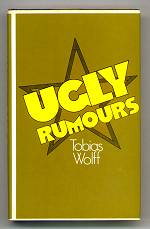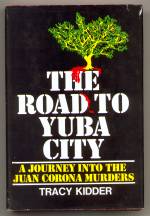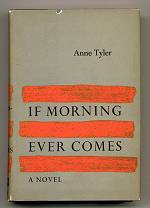Collecting Authors' First Books
(Ken's intro to our catalog of Authors' First Books)
 This catalog [see Authors' Firsts]
focuses on authors' "firsts" -- first
appearances, first books, first works of fiction, first novels.
The fame of the authors included herein varies widely: some are
names virtually everyone has heard; some are writers that few
people know of yet. What they share in their first or early
appearances in print is that, at the time, they were almost all
both relatively young and relatively unknown. The works had to
stand on their own merits rather than on their authors'
reputations. The quality varies substantially: some, like
Margaret Mitchell's Gone With the Wind and Harper Lee's
To Kill a Mockingbird, became instant classics, winning
literary awards and becoming perennial bestsellers; others -- like
Edward Abbey's Jonathan Troy, Tobias Wolff's Ugly
Rumours, John Cheever's The Way Some People Live and
Tracy Kidder's The Road to Yuba City -- were later viewed
by their authors as examples of youthful indiscretion or folly
and virtually disavowed -- never coming back into print even after
their authors were well-established literary figures. Some, like
Mitchell's and Lee's, were the only books their authors ever
produced; most often, however, these first books signaled the
start of long and productive literary careers.
This catalog [see Authors' Firsts]
focuses on authors' "firsts" -- first
appearances, first books, first works of fiction, first novels.
The fame of the authors included herein varies widely: some are
names virtually everyone has heard; some are writers that few
people know of yet. What they share in their first or early
appearances in print is that, at the time, they were almost all
both relatively young and relatively unknown. The works had to
stand on their own merits rather than on their authors'
reputations. The quality varies substantially: some, like
Margaret Mitchell's Gone With the Wind and Harper Lee's
To Kill a Mockingbird, became instant classics, winning
literary awards and becoming perennial bestsellers; others -- like
Edward Abbey's Jonathan Troy, Tobias Wolff's Ugly
Rumours, John Cheever's The Way Some People Live and
Tracy Kidder's The Road to Yuba City -- were later viewed
by their authors as examples of youthful indiscretion or folly
and virtually disavowed -- never coming back into print even after
their authors were well-established literary figures. Some, like
Mitchell's and Lee's, were the only books their authors ever
produced; most often, however, these first books signaled the
start of long and productive literary careers.
Someone once pointed out that the one thing all books share is that they had a first edition. So it is not that a book is found in its first edition, per se, that makes it valuable; rather, it is that the book itself made a significant impact or its author did, and consequently the book itself is considered "valuable" in some intangible way; its first edition, being the earliest example of this significant, or valuable, work tends to be considered valuable in an artifactual way. And, like any artifact, the scarcer the item and the more widely it is appreciated, the more expensive it is to acquire. The same is true for first books: every published author has had a first book. What makes a first book valuable, generally, is that either the book itself had immediate impact or that the book's author later came into prominence for some other work(s), thereby retroactively, as it were, establishing the "importance" of his/her first book.
A number of world-renowned authors had very modest first books, which gave little indication of the eventual esteem in which their authors would be held. Ernest Hemingway's first book -- a small pamphlet published in Paris and called, unpretentiously, "Three Stories and Ten Poems" -- was issued in an edition of 300 copies, most of which seem to have disappeared by the time his first novel, The Sun Also Rises, was published and he began a literary ascent that culminated in his being acclaimed in his time as the greatest American writer ever. Similarly, William Faulkner's first book, The Marble Faun, was published in an unheralded, small, fragile edition limited to approximately 500 copies, few of which have survived. Both books are worth in the neighborhood of $20,000 today, because of their rarity and because of their "importance" as the earliest published works by two of the greatest American writers, both of whom went on to become Nobel Prize winners. Another scenario -- but also typical of first books -- applies to John Steinbeck's novel, The Cup of Gold. It received mixed reviews, at best, upon publication and sold poorly -- the total sales amounting to only about 1500 copies, many of which went to libraries. The rest of the first printing sat in storage, unsold and, indeed, unbound until years later, after Steinbeck's literary reputation had been firmly established, when the remainder were bound up and issued by a new publisher. Consequently, the true first edition is extremely scarce. These days, the unsold books would have been remaindered or, if no one wanted them, pulped.
 When collecting first books, one is often dealing with an
author's scarcest work both in terms of sheer numbers -- first
novels typically having smaller print runs than later books,
after the author has a track record -- and also because a smaller
percentage of the copies of an author's first book are likely to
survive. Standing orders from libraries account for a
significant percentage of the total sales of literary works in
the U.S. and a smaller first printing means that fewer copies are
available for the rest of the book trade (library books, because
of the way they are marked, glued, pocketed, etc., are generally
ruled unfit for collecting later as rare books). Also, copies of
a first book do not go directly into the rare book trade or the
collector's market unless the book is an instant success; and by
the time an author is "established," attrition will have taken
its toll. After an author has a reputation, some copies of his
or her books will go into literary collections or author
collections immediately after publication. So, first books
usually have smaller print runs than later books, and fewer
copies of the initial print run are preserved than is
normally the case later.
When collecting first books, one is often dealing with an
author's scarcest work both in terms of sheer numbers -- first
novels typically having smaller print runs than later books,
after the author has a track record -- and also because a smaller
percentage of the copies of an author's first book are likely to
survive. Standing orders from libraries account for a
significant percentage of the total sales of literary works in
the U.S. and a smaller first printing means that fewer copies are
available for the rest of the book trade (library books, because
of the way they are marked, glued, pocketed, etc., are generally
ruled unfit for collecting later as rare books). Also, copies of
a first book do not go directly into the rare book trade or the
collector's market unless the book is an instant success; and by
the time an author is "established," attrition will have taken
its toll. After an author has a reputation, some copies of his
or her books will go into literary collections or author
collections immediately after publication. So, first books
usually have smaller print runs than later books, and fewer
copies of the initial print run are preserved than is
normally the case later.
The question of what first books to collect -- or, indeed, which first books to include in a catalog such as this -- has no simple, single answer. All of the writers included in this catalog have produced works that have left a mark on our literature, and have influenced our culture and, thus, by extension, the way we look at the world. Some, like Hemingway or Steinbeck or Fitzgerald, are universally considered classics; other, younger writers, like Tim O'Brien or Leslie Silko, have taken particular events or areas of experience that might otherwise have remained hidden and made them accessible to large numbers of contemporary readers, broadening our horizons and expanding our cultural consciousness. Others have won prizes recognizing the value of their work or -- as in the case of an idiosyncratic writer like Edward Abbey -- simply pursued a personal vision with enough relentlessness and persuasiveness as to in effect create a new category of awareness: in Abbey's case, the idea of the social, and even spiritual, value of wilderness -- which in American literature dates back to Thoreau and beyond -- was extended to include even the seemingly barren desert Southwest, and the notion of the intrinsic value of wilderness itself, of all kinds, is now a truism. All of the writers included herein have made some such mark; many of them are still writing, and will continue to do so. This is a representative sample, not a definitive list, but all of these writers have made a difference, and their books have helped shape the consciousness of our times.
Since the advent of collecting modern first editions -- a practice that has been dated to the time of the Great Depression, when book collections in more traditional fields failed to maintain the values they had achieved in the heady economic times of the Twenties -- personal taste has been as much a determinant of collectibility as the more traditional criteria, including antiquity, scholarly significance and breakthrough technologies. Auction catalogs from the late Twenties and early Thirties show a healthy interest in such writers as Conrad and Galsworthy, Faulkner and Steinbeck -- all of whom, with the exception of Conrad, were still writing at the time. The "prices realized" can be instructive: Galsworthy's books commanded much more than Conrad's in those days, whereas today the reverse is true. Faulkners and Steinbecks could be had, signed, for a few dollars. Today, however, even unsigned Faulkners and Steinbecks from the Thirties sell for hundreds of dollars; signed copies can bring thousands. The comparison to today's authors should not be overlooked: some of today's younger writers will become the Faulkners and Fitzgeralds of their day -- the writers who most fully capture an essential element of their time, preserve it for posterity, and connect it with the fundamental human experience. And, as was the case with Faulkner's and Hemingway's and Steinbeck's first books, the first books by today's young writers are likely to be lost in the buzz and hype of an American publishing industry that releases over 100,000 titles a year.
Many of the contemporary writers included in this catalog have followed such a pattern: their first books were issued in small quantities, sometimes by small publishers, well before they made a name for themselves. By the time their work finally reached a wide public and demand for their early books increased, the books had long since vanished. Cormac McCarthy's first book, The Orchard Keeper, while not as scarce as The Marble Faun or Three Stories and Ten Poems, nonetheless had over a quarter century to fade into obscurity before his novel All the Pretty Horses won the National Book Award and the National Book Critics Circle Award and stimulated interest in his earlier work. (All the Pretty Horses had hardcover sales more than ten times greater than all five of his previous books combined). Similarly, Anne Tyler's first several books were published in editions of 5000 or so, whereas today her books have print runs of 100,000 or more. And in the nearly two decades between her first book, If Morning Ever Comes, and her first bestseller, Dinner at the Homesick Restaurant, the supply of her early titles in collectible condition simply dried up.
 In some cases, like Hemingway's and Faulkner's, an author's
first book was published by a small press, well before he or she
could catch the interest of the major publishers. Occasionally
such books can become readily available when the author has a
breakthrough, because the press was so small that they
didn't sell out the original book, and copies remain warehoused
until there is more demand for them. However, it is far more
common for a first book done by a small press to become
exceedingly difficult to locate retrospectively. Examples
abound, and the greater the length of time between the first
book and the later "breakthrough," the more difficult the job of
finding the author's first book. We have had innumerable
cases of collectors who have "nearly completed" an author
collection only to balk at the price of the first book, since it
is so much higher than what they've paid for any (sometimes
all) of the other titles in the collection. And then they
have watched the prices continue to escalate from there. At each
new price level, the former price looks attractive. But the
pattern was clear from the start: the first book(s) will
almost always be the scarcest -- and thus in some sense the most
desirable -- of an author's work.
In some cases, like Hemingway's and Faulkner's, an author's
first book was published by a small press, well before he or she
could catch the interest of the major publishers. Occasionally
such books can become readily available when the author has a
breakthrough, because the press was so small that they
didn't sell out the original book, and copies remain warehoused
until there is more demand for them. However, it is far more
common for a first book done by a small press to become
exceedingly difficult to locate retrospectively. Examples
abound, and the greater the length of time between the first
book and the later "breakthrough," the more difficult the job of
finding the author's first book. We have had innumerable
cases of collectors who have "nearly completed" an author
collection only to balk at the price of the first book, since it
is so much higher than what they've paid for any (sometimes
all) of the other titles in the collection. And then they
have watched the prices continue to escalate from there. At each
new price level, the former price looks attractive. But the
pattern was clear from the start: the first book(s) will
almost always be the scarcest -- and thus in some sense the most
desirable -- of an author's work.
The question of whether these books' value will last is a legitimate one. There's no certain answer since the verdict of history has not yet been rendered on today's writing. Much discussion and argument can take place about which works will, or won't, survive. Many important figures of 19th century literature have faded into obscurity over the years; others, like Melville, whose literary reputation was resurrected in the 1920s decades after his death, are now viewed as key figures of their time. Will John Barth and Margaret Atwood be more likely to be read a hundred years from now, or Anne Rice and Stephen King? No one knows. However, Allen and Pat Ahearn, in their volume Book Collecting: A Comprehensive Guide (NY: Putnam, 1995), tracked a list of more than 200 collected authors for whom accurate price records existed in the late Thirties and early Forties and found that 50 years later all but 8 of the authors were still widely collected and the values of their first editions had appreciated at a rate quadrupling the Cost of Living Index. The combination of scarcity and literary significance will always be a primary determinant of price, because the latter fuels demand and the former limits supply. First books in general tend to be scarce; first books by significant literary authors may well represent one of the safest bets in collecting modern literature.
But the reason for collecting literary first editions, including first books, should not be primarily financial. There are safer bets if one is looking for return on investment. The reason for collecting first editions resides in what underlies the monetary value of the artifact, which is the intangible "value" of the books themselves -- the words and thoughts expressed and their capacity for transforming our understanding. It makes as much sense to collect first editions primarily for their monetary appreciation as it does to hang bank notes on one's wall instead of artwork. The most important criterion of what is collectible, ultimately, is whether the item in question has specific meaning for you and enhances your appreciation of life. For some people, artwork, ceramics, lamps or even bank notes do that; for others, books do, and collecting books makes sense. In the end, you create your library and your library defines you. Collecting the authors whose work speaks directly to your heart is the "safest" course, because it ensures that your collection will always be valuable, regardless of what others would pay for the books you own.
Copyright © 1997 by Ken Lopez